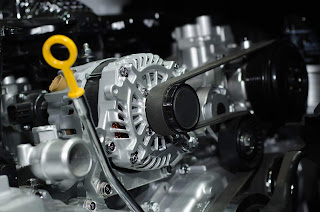The ever-complex engine compartment of your Orlando Toyota
car is home to a number of different parts and mechanisms that all work
perfectly together. Apart from the various fluids and gears at work in your car,
engine belts are there to keep your moving parts moving. While it’s easy to
forget these essential engine parts until you hear a squeal or experience your
car overheating. Luckily, Toyota of Orlando is here with an easy guide on
engine belts, so you can better understand these essential engine components.
Different types of Orlando Toyota engine belts
Serpentine belt
From 1990 and on serpentine belts have been the most commonly
used belts in engines to keep essential functions like power steering, air conditioning,
your Orlando Toyota water pump, and the alternator operating normally.
While serpentine belts typically last for a long time,
typically around 50,000 to 100,000 miles, they’re no stranger to wear and tear
over time. Your Orlando Toyota car’s serpentine engine belt can experience squealing or chirping noises which can indicate slipping or low belt tension. Cracks and
wear can usually be spotted on the belt. Your vehicle’s air conditioning system
and engine could fail as well.
Drive and V engine
belts
Typically found on older Orlando Toyota vehicles, these
engine belts run off of tension from a crank pulley and can only pass through
two accessories. Unlike serpentine belts that run through multiple pulleys and
accessories, V belts operate on individual engine components so there are individual
engine belts for the power steering, air conditioning, alternator, water pump,
and so on.
While it may seem inconvenient to have so many belts in your
Orlando Toyota engine compartment, V belts can keep your car running, even in
the event that you have a belt failure. In comparison, when a serpentine belt
breaks, the entire engine fails.
Loose or over-worn V engine belts can cause squealing or individual
component failure. To test for this belt’s tension, put your finger on the
midway point of the longest stretch of belt and press down. You should be able
press down no more than a half an inch.
Timing belts
Timing is always critical when it comes to your Orlando Toyota engine working properly and that’s where your timing belt comes into
play. Essentially, this engine belt connects the crankshaft and camshaft to keep
them synchronized. Because of the importance of this belt it’s typically covered
and can’t be seen unless the cover’s removed.
The timing belt should be replaced or inspected every 60,000
to 90,000 miles and could be damaged if left unchecked. This part can be substituted
with timing chains to increase the engine’s lifespan.
Like everything on your car, damage and wear and tear can
happen at any time. To keep your engine running properly, make sure to stop by
Toyota of Orlando’s auto service department. Give us a call at (407) 298 – 0001
for more details!


No comments:
Post a Comment
Note: Only a member of this blog may post a comment.